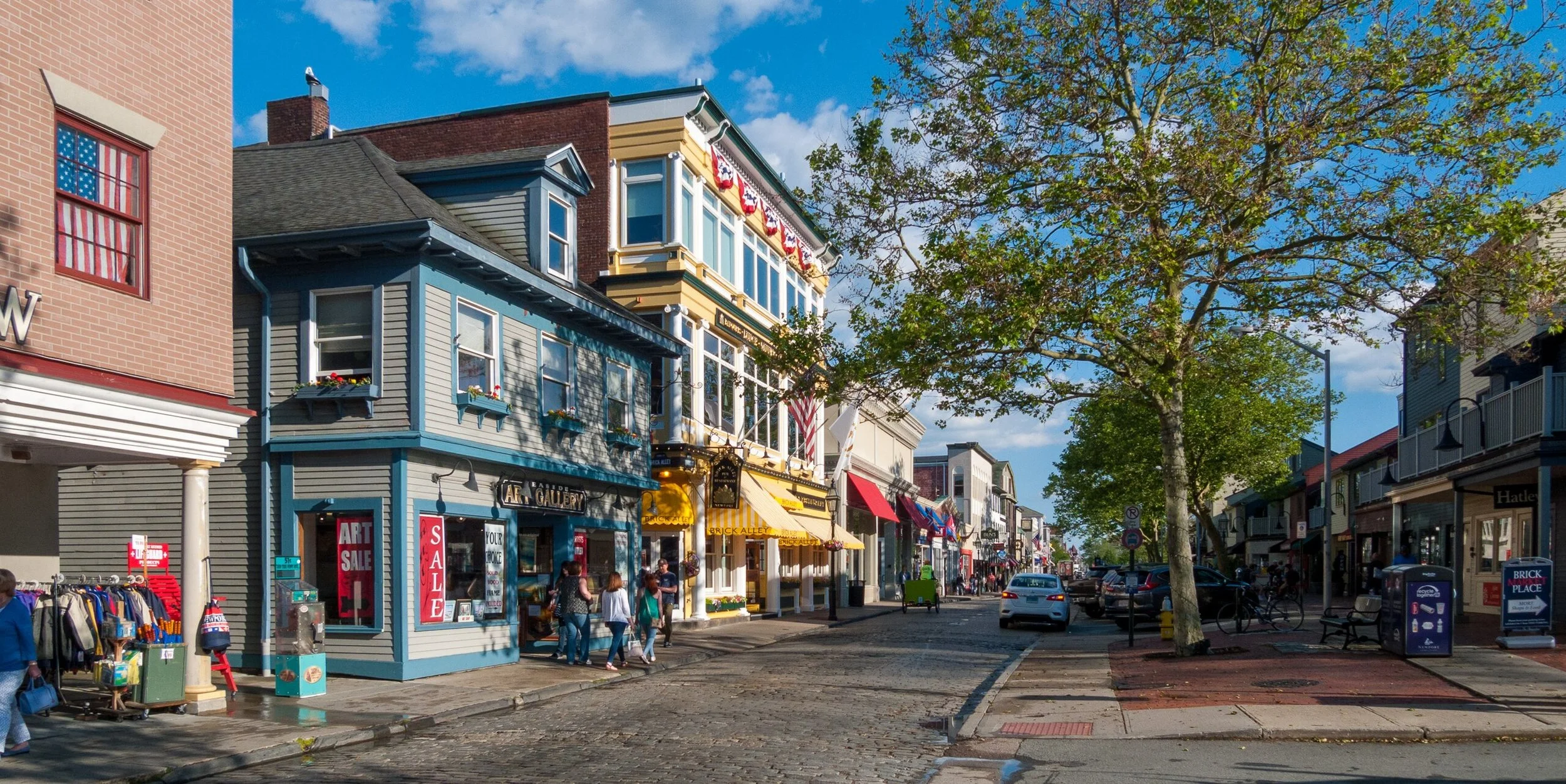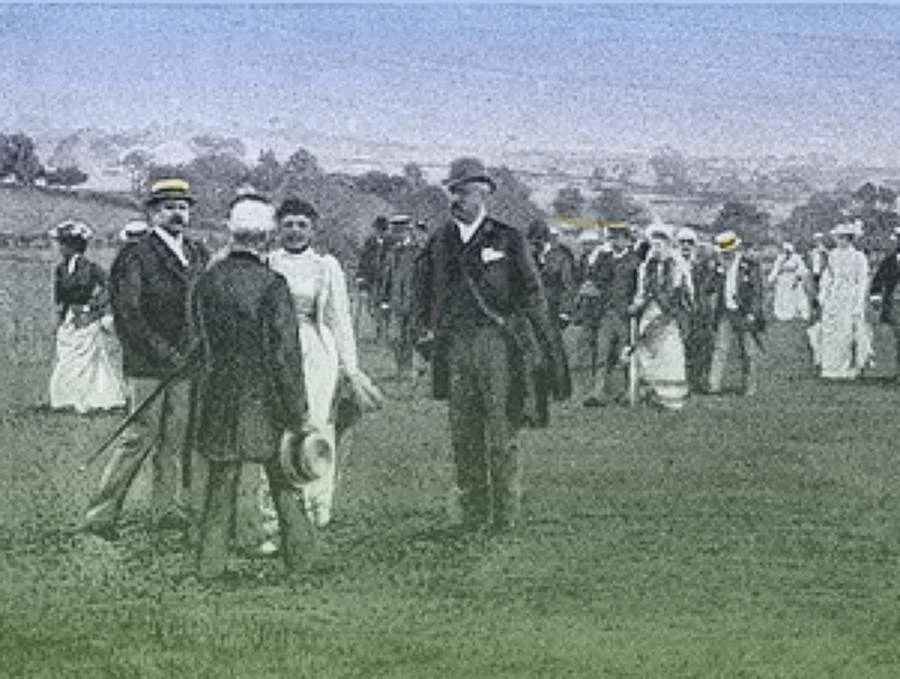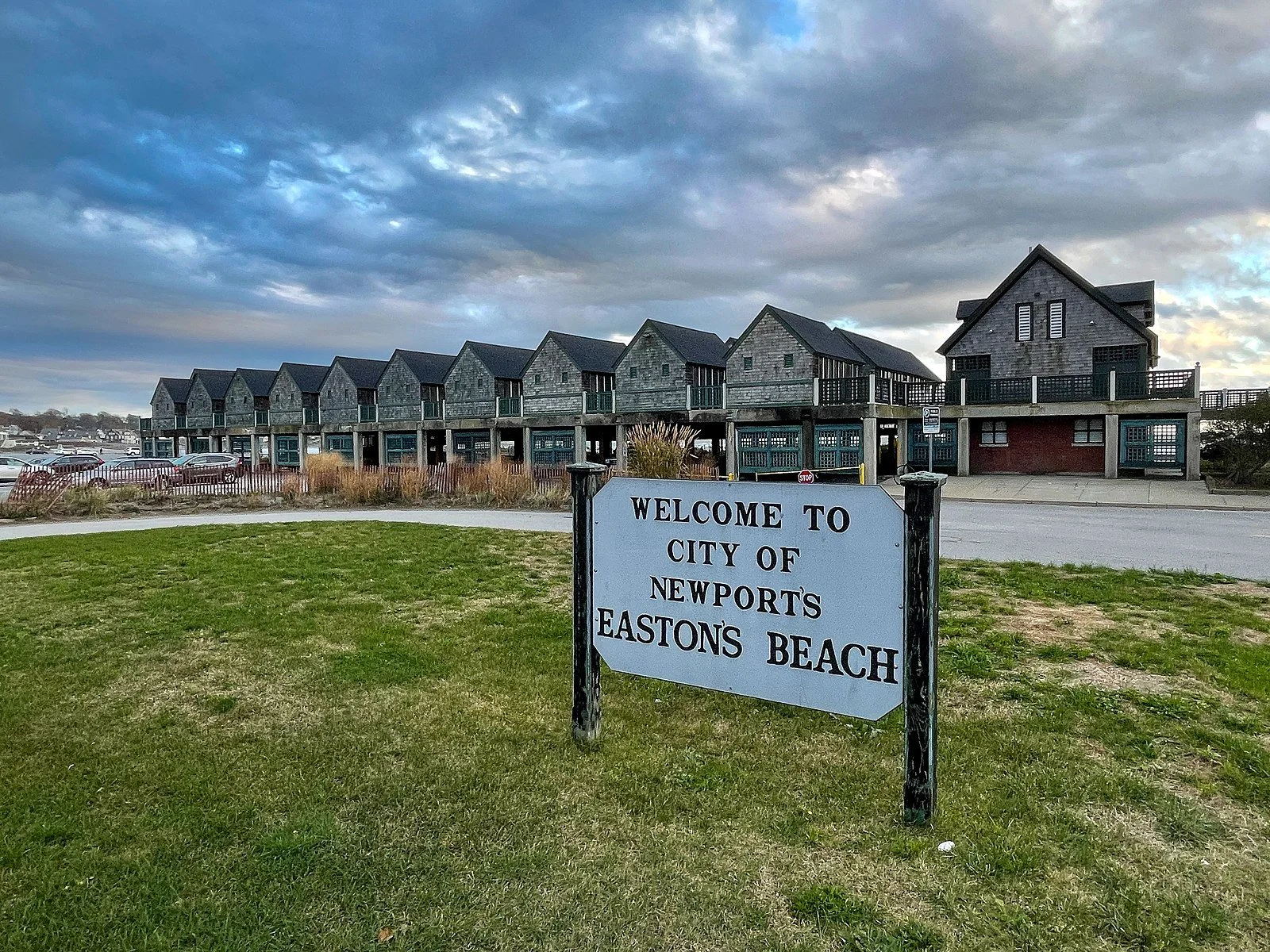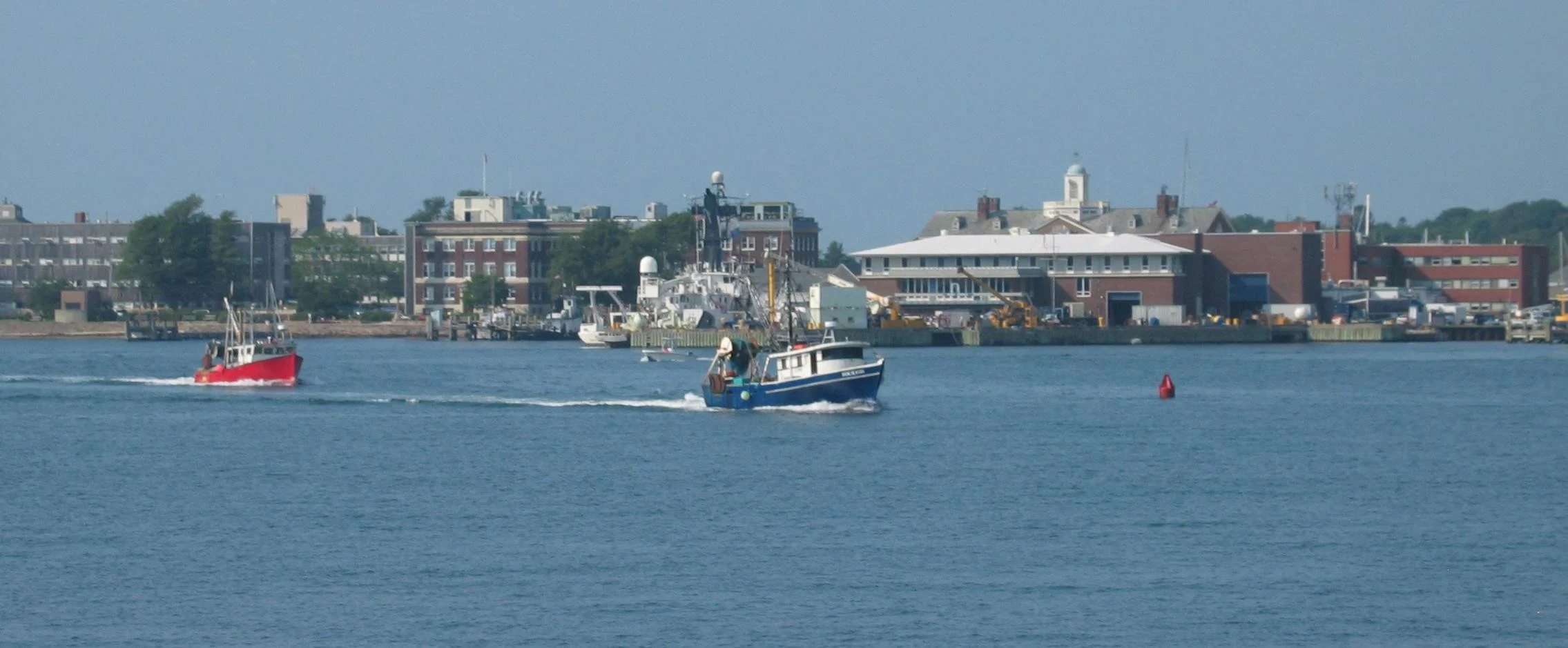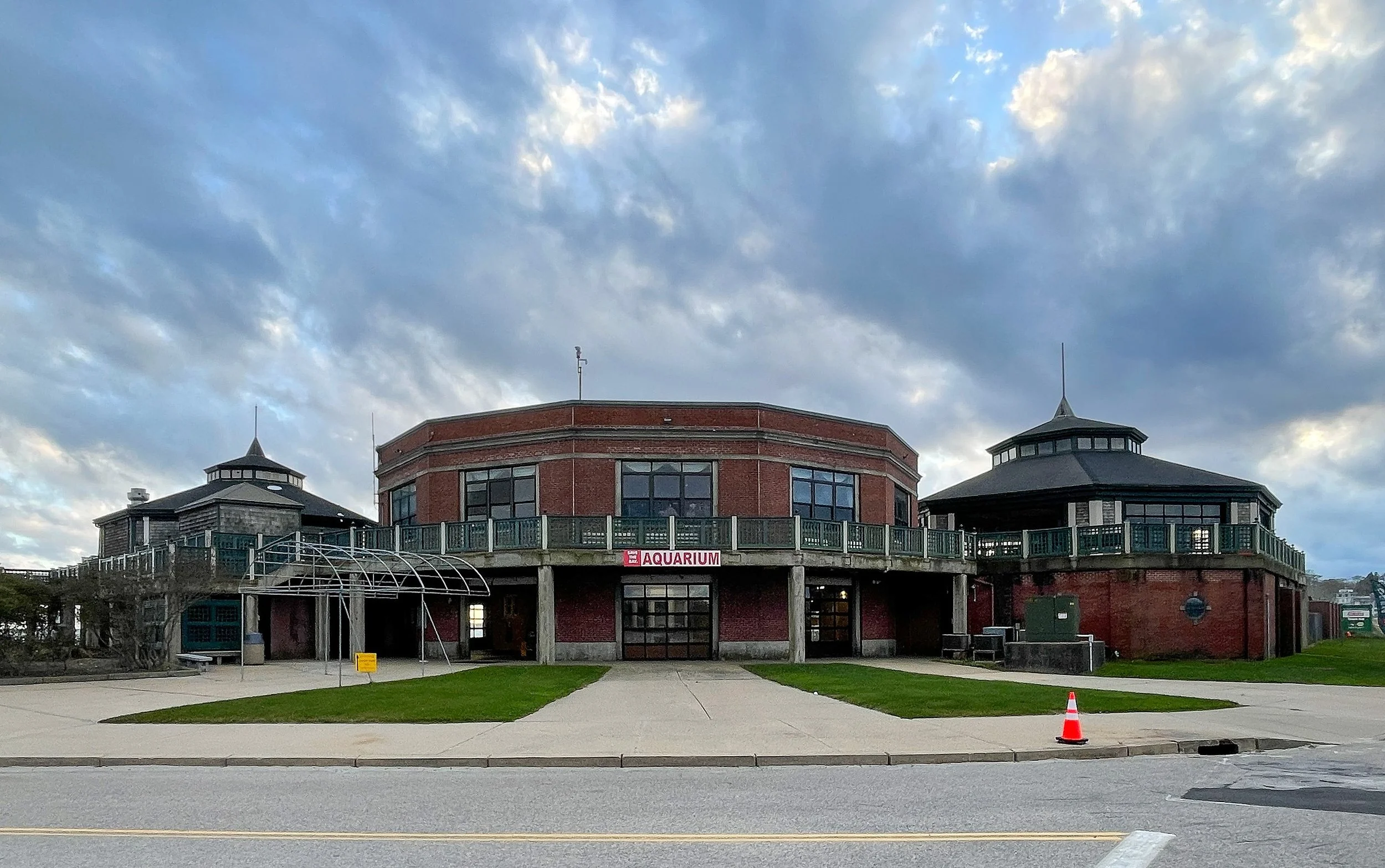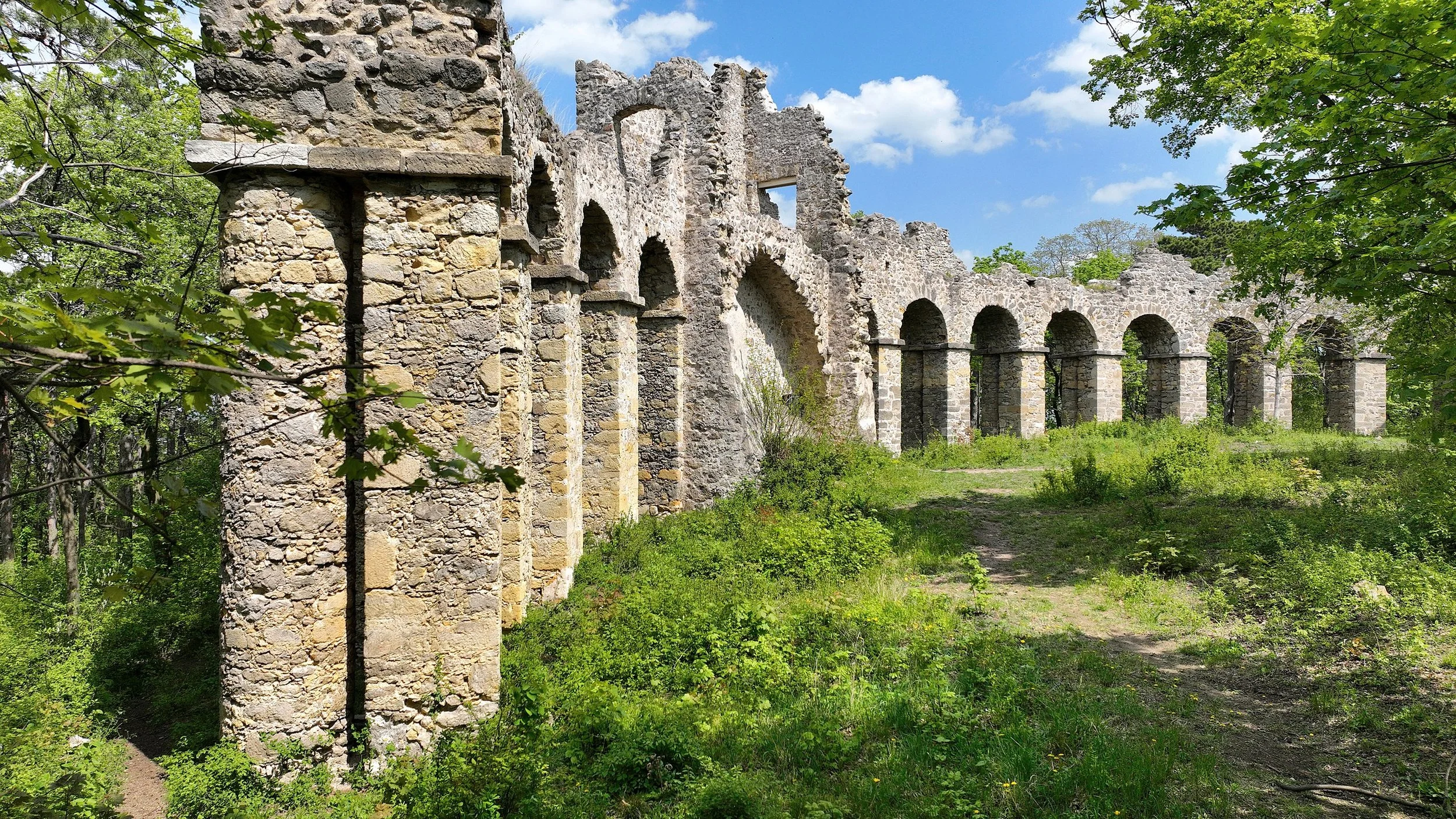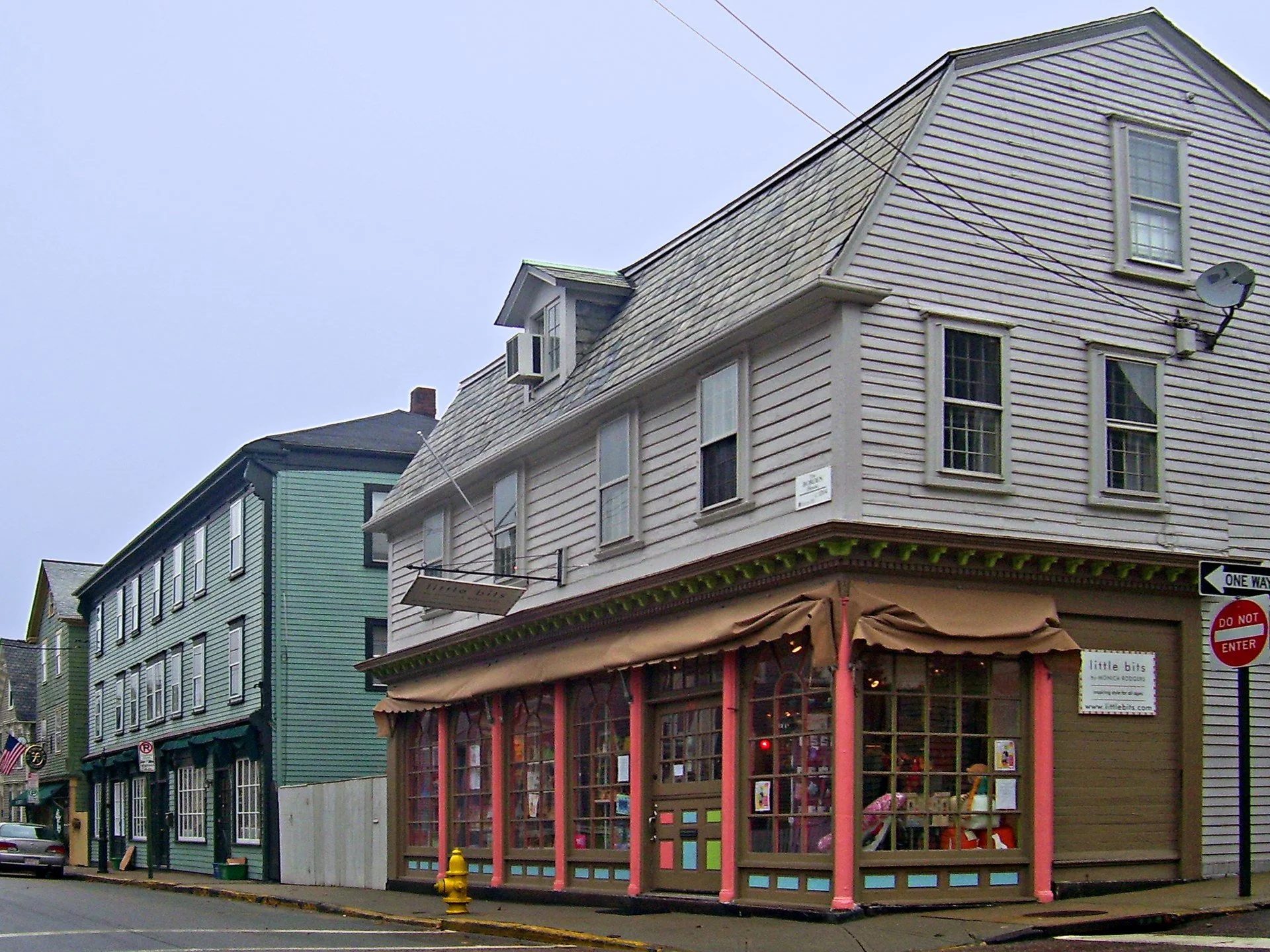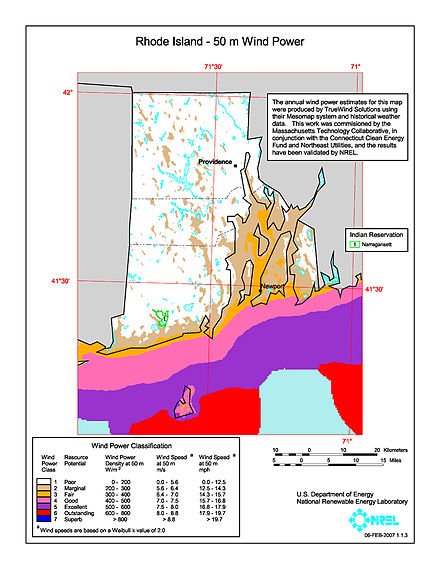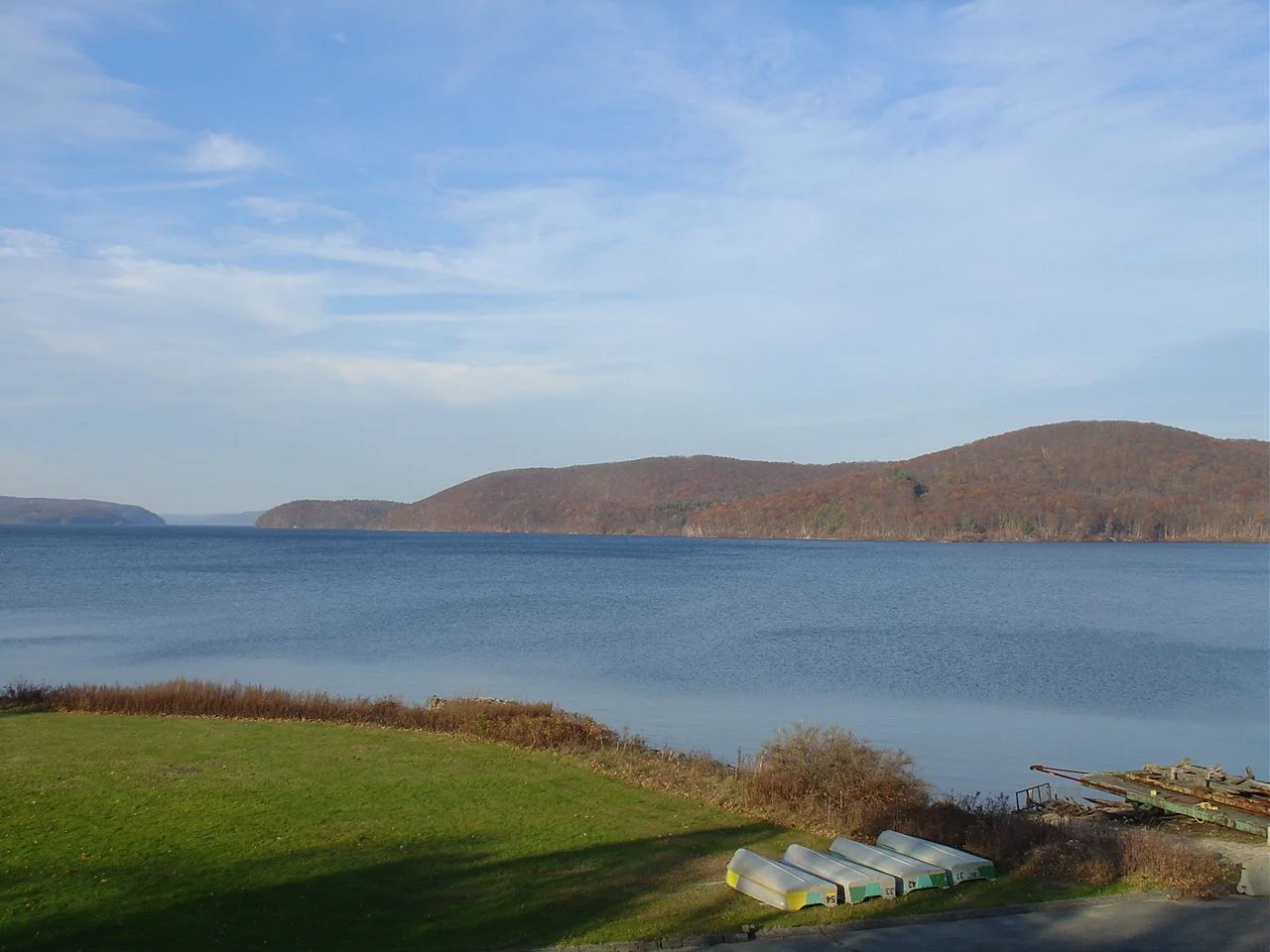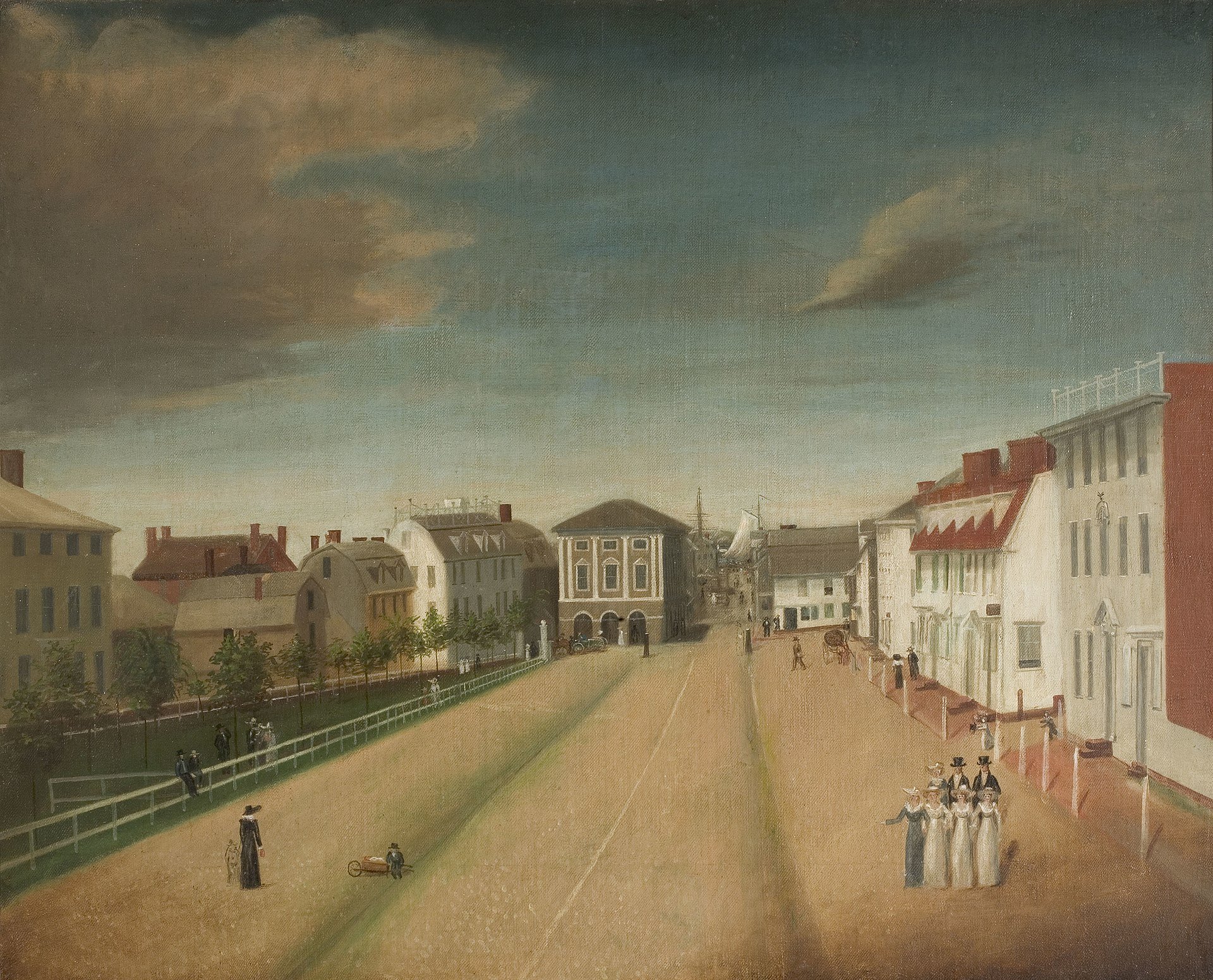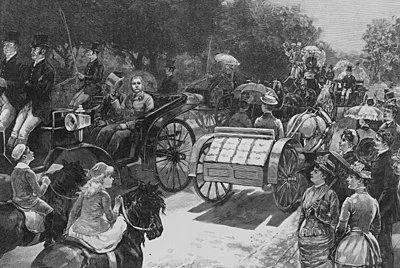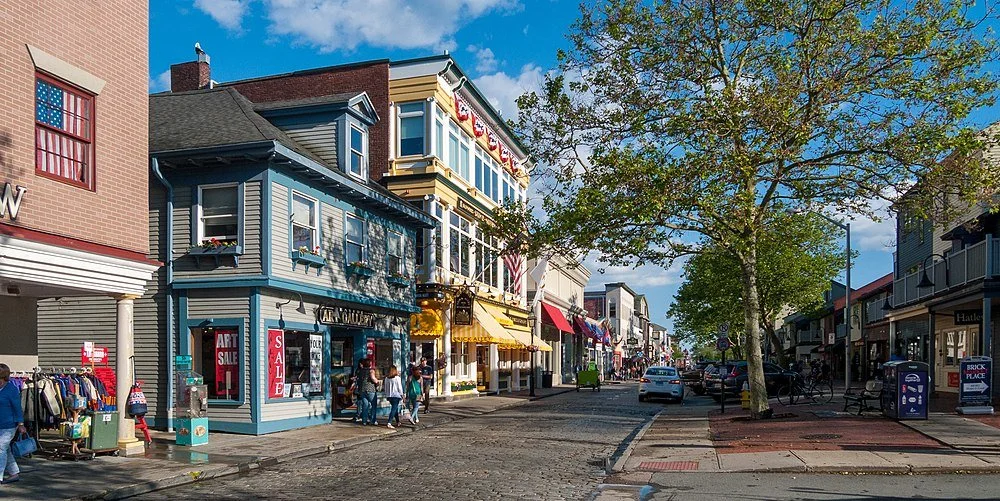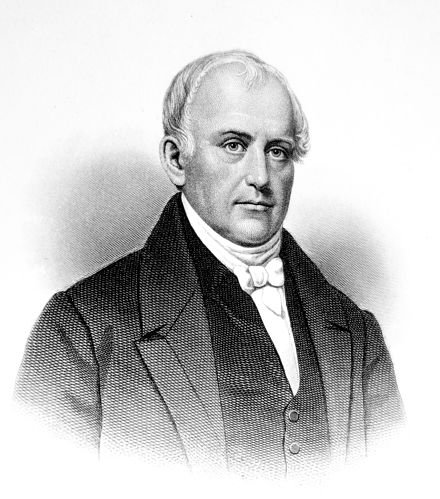
ADU’s in tight cities
Thames Street, the best-known retail strip in Newport. (Photo by Kenneth C. Zirkel)
Adapted from Robert Whitcomb’s “Digital Diary,’’ in GoLocal24.com
Tight little Newport, R.I. and many other places, seek to address the housing shortage and cost by encouraging the construction of accessory dwelling units (ADUs) on owner-occupied residential property. This housing is generally supposed to be primarily for elderly and/or disabled people, and in The City by the Sea would be limited to one-bedroom and studio units of no more than 900 square feet and two-bedroom units at 1,200 square feet.
Certainly creating more space for the elderly, the fastest-growing part of the population, is a fine idea! Rhode Island is ranked as eleventh among the states in its percentage of people 65 and over. We’ll see if many much younger people end up living in the ADU’s, whatever the laws. Meanwhile, using them for short-term rentals – a temptation in mega summer resort city Newport – is banned. All this will be tough to monitor.
Then there’s the always tricky parking issue. While the new rules say that no additional parking would be required for a new ADU, currently required parking removed as part of building an ADU would have to be replaced.
I’ll be curious to see if many people without cars move into the ADU’s, opting to rely on bikes, Uber and Lyft, and public transit instead. Maybe many of them will be young adults.
In any event, increasing the supply of housing is essential, but tough. Too many people oppose greater density, even as the population swells. They want wide-open spaces in their neighborhoods.
'A primal presence'
“Half Tree” (oil on canvas), by Barbara Groh, at Gallery Sitka, Newport, R.I.
She says in her artist statement:
“My visual inspiration began early with Abstract Expressionism. As I am primarily an abstract artist, I aspire to have my work affect others as I have been by provoking thought, emotional experiences, moods, and aesthetic pleasure.
“Landscape is a primal presence for me. I explore by walking in diverse environments and return to the studio to transform my experiences into physical being. These inspirations can happen just outside my studio door or in distant lands with unfamiliar landscapes and cultures.
“My paintings in oil, acrylic, or cold wax may reflect a quiet practice of noticing inner space, peace, and presence, while others may reflect a desire and will to express freedom and unencumbered thought. Both encompass the moment and the past – a synthesis of physicality, perception, meditation, and inner movement.’’
Founders Hall at the U.S. Naval War College, in Newport.
Dictator of the social climbers
Newport picnic supervised by Ward McAllister.
"Snobbish Society's Schoolmaster” —Caricature of Ward McAllister as an ass telling Uncle Sam he must imitate "an English snob of the 19th Century" or he "will nevah be a gentleman".
Text excerpted from a New England Historical Society article by Emily Parrow
“In Gilded Age Newport, Rhode Island, an invitation to one of Ward McAllister’s summer picnics could make or break a hopeful social climber.
“One contemporary aptly described this era as ‘an ever-shifting kaleidoscope of dazzling wealth, restless endeavor, and rivalry.’ American ideas about class were changing, especially in cities. Old and new money mixed like oil and water. The increase in American fortunes necessitated stricter guidelines for social acceptance. Enter McAllister, a controversial figure who coached this evolving class of insecure millionaires in Old World aristocratic customs.’’
Retreating looks wiser than rebuilding on the coast
Adapted from Robert Whitcomb’s “Digital Diary,’’ in GoLocal24.com
There’s intensifying debate in many coastal and other areas that are increasingly flood- and erosion-prone in our warming climate on whether we should repeatedly repair or replace flood-damaged structures; have taxpayers pay some or all of the cost to move them to higher ground, and what to put in their place. I think the obvious answer in many places is to retreat and create flood-mitigating parks with (new?) marshes and thick vegetation and other water-absorbing materials that can reduce damage to the higher-elevation properties nearby. Of course, in such densely built urban areas as Newport’s Point neighborhood and Boston’s Seaport District that’s tricky.
I thought about this the other day when reading about the debate in Newport over whether to abandon the idea of rebuilding storm-damaged facilities at Easton’s Beach and stage a retreat. It seems clear to me that given projections of continued global warming and associated sea-level rise, that spending money to rebuild the Easton’s Beach amenities would soon be seen as a waste of money. Replenishing the sand that storms have washed away is expensive enough, though needed to keep the beach as a major attraction for locals and tourists alike.
Forecasts for the 2024 hurricane season are starting to come out. It looks, er, exciting.
Measuring CO2 in the Ocean
Edited from Wikipedia caption: “This diagram of the fast carbon cycle shows the movement of carbon among land, atmosphere and oceans. Yellow numbers are natural fluxes, and red are human contributions in gigatons of carbon per year. White numbers indicate stored carbon.’’
Thank you, Paul Salem, for giving the Woods Hole Oceanographic Institution (WHOI) $25 million for ocean research in general and, in particular, to study the oceans’ capacity for removing carbon dioxide from the atmosphere, into which we’ve been putting vast quantities of climate-warming CO2 by burning fossil fuels, clear-cutting forests, degrading wetlands and engaging in industrial agricultural practices (especially large-scale livestock production). The heating of our climate is accelerating, and more than 70 percent of the world’s surface is ocean.
Note that this excess carbon dioxide is also acidifying the water, harming sea life.
Mr. Salem, a billionaire, was a partner in Providence Equity Partners, and in 2022, he became chairman of WHOI’s board.
WHOI president Peter de Menocal said: “There is a tidal wave of ‘blue carbon’ solutions to climate change on the horizon, some proven, but most completely novel and in need of testing to investigate their safety and effectiveness. The ocean can help us avert a climate crisis, but we need to also ensure the long-term health of marine ecosystems and the communities that rely on ocean resources. This far-sighted gift {by Mr. Salem} will help us stay ahead of what is already a billion-dollar industry and inject some much-needed reality into the carbon market.”
xxx
I have always had a soft spot for Woods Hole, because this windswept village, basically a kind of college town within Falmouth, is so beautiful and dramatic; because of WHOI and other marine-related institutions based there, and their smart and interesting people, and because an important part of my father’s family lived in and around it. Some moved there in the 17th Century when, as Quakers, they fled Puritan persecution in and around Boston, and others came down from the Boston area as summer people when trains were extended to Cape Cod in the 1870’s. There were more than enough eccentrics among them; some had weird whirligigs on their roofs and some were recluses.
View of downtown Woods Hole, including Marine Biological Laboratory and Woods Hole Oceanographic Institution buildings.
Offshore wind-power battles keep coming
“50 m” means mean wind speed at 50 meters above the ground or water.
Adapted from Robert Whitcomb’s “Digital Diary,’’ in GoLocal24.com
As usual, whatever the huge environmental and economic benefits of green-energy projects, some people try to block them, especially affluent folks who don’t want to look at them or even if they can’t see them hate the very idea of being anywhere near them. Sometimes the blocking attempts are on their own, and sometimes they get the help of the fossil-fuel industry. (Hey, who wants competition?!) Consider that a far-right (euphemism – ‘’libertarian”) Trump-connected outfit called the Caesar Rodney Institute, with ties to the oil industry, is one of the groups fighting offshore wind projects.
The latest example in these parts is a bunch of people in the Cape Cod town of Barnstable trying to stop electrical cables from the offshore wind farms of Commonwealth Wind and Park City Wind from being laid 50 feet under beaches.
The foes like to cite alleged health risks from electromagnetic fields and fires. But in fact putting these cables deep underground is the safest way to go. How many of these opponents have complained about the risks from overhead lines, which produce -- obviously! --far, far more human exposure to electromagnetic fields than can underground cables, require cutting down wide swaths of woods and otherwise disturbing the environment to make space for them and can (albeit rarely) cause fires, of which California is the most dramatic example.
There have long been underground cables all over America that carry the same voltages that would come from these offshore wind projects. And cables from offshore wind farms in Europe have been put under beaches without incident, but it’s a lot easier to do such projects there than here.
Hypocrisy makes the world go round.
And now some powerful folks in Newport seek to block wind turbines in the water far off that city. One foe is self-described “Trumpette’’ Dee Gordon, whose properties, with her husband, include a place on Ocean Drive.
Of course plenty of people, Trumpette or otherwise, don’t want wind turbines near them.
Hit this link, this one and this one. And this one.
And this one. And, finally, this one.
I hope that Massachusetts officials will favor the broad public interest and not let local opposition block what would be an environmental and economic boon for our region. But lots of people still seem to prefer burning oil, gas and coal from outside our region rather than putting up with nonpolluting, locally produced energy.
Newport and China
At “The Celestial City: Newport and China” show at Rosecliff mansion, Newport through Feb. 11, except Nov. 16-Dec. 3.
The Preservation Society of Newport County (whose show it is), explains that the show:
“{E} explores China’s deep influence on Newport from the 18th century through the Gilded Age, when the city emerged as America’s premier summer playground and the fall of China’s last imperial dynasty transformed the ancient nation. The extraordinary objects displayed include more than 100 works in a range of media, from paintings, ceramics, and photographs to fashion, lacquerwares, and lanterns. Contemporary artworks by Yu-Wen Wu and Jennifer Ling Datchuk illuminate Chinese contributions to Newport as well as hidden connections between the Newport mansions and the Chinese-American experience.’’
Smart refugees at Newport aquarium
A Common Octopus, the kind that shows up in southern New England’s coastal waters. Octopuses are smart!
We must fight back
Miantonomi monument in Newport
Below is speech by the Narragansett Tribe sachem Miantonomi (1600 (circa)-1663) in 1640 in response to the relentless land grabs by English settlers. There are various spellings of the sachem’s name.
Brethren and friends, for so are we all Indians as the English are, and say brother to one another; so we must be one as they are, otherwise we shall be all gone shortly, for you know our fathers had plenty of deer and skins, our plains were full of deer, as also our woods, and of turkies, and our coves full of fish and fowl. But these English having gotten our land, they with scythes cut down the grass, and with axes fell the trees; their cows and horses eat the grass, and their hogs spoil our clam banks, and we shall all be starved; therefore it is best for you to do as we, for we are all the Sachems frome east to west, both Moquakues and Mohauks join with us, and we are all resolved to fall upon them all, at one appointed day.
An 1874 illustration of Uncas killing Miantonomi in 1643
Blue but happy
“Happy Dance” (encaustic and ink painting), by Nancy Whitcomb, in the “Out of the Blue” group show, at Spring Bull Gallery, Newport, R.I., through Oct. 29
Kevin Gilmore, the show’s juror, says:
“A word on ‘Out of the Blue’. The color blue is the first ‘clue’ in the prompt for this exhibition. Not surprisingly, for a gallery located on Aquidneck Island, surrounded by the beautiful shorelines and waters of Narragansett Bay, the color blue dominated the group of submissions.’'
Friendship
“Combinatti #3 (bronze), by J.T. Gibson, in the group show “Lean on Me,’’ at Atelier gallery, in Newport (R.I.), through Oct. 16
The gallery says:
“The show highlights our appreciation for blacksmithing, forged steel, woodworking and cast bronze work both in Newport and in Santa Fe, N.M. Metal casting is a process in which hot liquid metal is poured into a mold to solidify — an art developed over 7,000 years ago during the Bronze Age.’’
Save The Bay Exploration Center and Aquarium, in Newport
—Photo by Kenneth C. Zirkel
Relishing ruins
At “The Bells,’’ in Newport
— Photo by GoLocalProv.com
The amphitheater, artificial ruins in Maria Enzersdorf, Austria, built in 1810/11
— Photo byu C.Stadler/Bwag
Adapted from Robert Whitcomb’s “Digital Diary,’’ in GoLocal24.com
The state-owned, graffiti-rich carriage house and stables of a once stately Newport mansion, which was built in 1876 and called “The Bells’’ and torn down in the ‘60s, will finally be demolished. That’s after four young people who were playing there were injured when part of the roof collapsed. The structures probably should have been demolished years ago.
Newport has its fair share of residential monuments from the first Gilded Age (semi-officially roughly 1870-1900, though some extend it through The Twenties), but I’d guess that few if any, others are in such a mess as “The Bells.’’ The current Gilded Age, still going strong, began in the 1980s, when, under the Reagan administration, taxes were slashed for the very rich.
Places like “The Bells’’ lure young “explorers,” especially boys, intent on mischief or innocent fun. I well remember as a kid entering (i.e., trespassing) such decayed mansions along the Massachusetts Bay shoreline near our house. Most were, or had been, summer places. Perhaps some were abandoned, or just started to be neglected, when the owners ran out of money in The Depression. Most were gray-shingle houses that started to be put up after the Civil War. But some of the newer ones had Spanish Mission-style stucco walls, fountains and statuary, which were popular in The Roaring Twenties. Newly (if only briefly) rich people liked what they saw of these houses on Florida’s Gold Coast and in Los Angeles.
Kids would smoke in them (raising the danger of fire) or engage in such idiotic behavior as BB gun fights.
In the 18th Century and early 19th centuries in Europe, especially in England, there was a mania for building fake ruins; some draw tourists to this day. Maybe some falling-down Newport mansions can someday serve a similar purpose. Crumbling old houses covered with vines can look romantic, and are spawning grounds for entertaining ghost stories. Just kidding. The building inspectors probably wouldn’t allow it.
Certain kinds of intensity
Left, “Spring Commuter’’ (oil on canvas), by J.C. Leyendecker (1870-1951), for the May 6, 1916 cover of The Saturday Evening Post. Right, “Threading the Needle” (oil on canvas), by Norman Rockwell, for the April 8, 1922 cover of the same magazine. Both at the National Museum of American Illustration, Newport, R.I.
The western facade of the mansion Vernon Court, at 492 Bellevue Ave., Newport R.I., home of the National Museum of American Illustration. It was built in 1900.
Liability Lane
A noncollapsed part of Newport’s Cliff Walk.
— Photo by Giorgio Galeotti
Adapted from Robert Whitcomb’s “Digital Diary,’’ in GoLocal24.com
Will they soon have to patch and fill along and on Newport’s famous Cliff Walk every few months, what with rising seas and more intense storms? The latest drama came in a Dec. 23 tempest in which part of the walk’s embankment collapsed. A section of the walk itself collapsed last March in a storm.
Maybe they should change the name of this tourist attraction to Liability Lane.
But the big thing to watch in The City by the Sea is the redevelopment and, we hope, beautification, of the ugly North End.
Speaking of the tourist mecca of Newport, the country, including New England, will likely go into a recession this year, and unlike in the pandemic recession, the Feds can’t be expected to bail out the states. So the states better pump up their rainy-day funds. Rhode Island, for its part, should intensify its promotion of warm-weather tourism, especially in such nearby areas as Greater New York City, to get more sales tax revenue to help offset the decline in other tax revenue.
Tax challenges in a resort town
Colonial era buildings in a Newport historic district.
— Photo by Daniel Case
Newport Tax Change
Adapted from Robert Whitcomb’s “Digital Diary,’’ in GoLocal24.com
Newport has adopted a new two-tier residential tax system that may cut taxes for many homeowners. The people who would get the break include owners of single-family homes who prove that they’re residents of the City by the Sea for more than seven months a year as well as owners of residential rental properties of three or fewer units whose renters’ leases run for at least a year.
The tax rate will remain higher for non-owner-occupied housing.
Earlier this year, Rhode Island state Sen. Dawn Euer said of the state legislation authorizing the change:
“As we know, our whole state and Newport especially are deep in an affordable housing crisis, and residential property tax relief is one tool to help address affordability…. Vacation rentals and short-term rentals take away from year-round housing, and while they do provide revenue, they contribute to our city’s housing crisis. Making a distinction between them will give residents the tax relief they need, and encourage property owners to create and maintain the permanent housing we desperately need.”
This arrangement should help stabilize housing in the city, which has long been destabilized by the high number of financially alluring (for property owners) expensive short-term warm-weather or even weekend rentals. But it’s hard to know what the effect on total property-tax revenue for the city might be. It will probably take a year to find out.
In any event, some lessons for other communities will come out of the Newport program, especially those in coastal resort areas.
N.E. clean-energy update
2007 U.S. Department of Energy wind resource map of Rhode Island
Adapted from Robert Whitcomb’s “Digital Diary,’’ in GoLocal24.com
I wonder how Newporters and tourists will respond to the sight on the horizon of 100 offshore wind turbines to be put up by Revolution Wind about 15 miles south of Little Compton. And there are other big offshore “wind farms’’ in the works south of New England. The Revolution Wind turbines will be the closest to Rhode Island.
There will be complaints from some folks who don’t want to look at them, even from a distance, but most people will get used to them fast, as they generally do with big new infrastructure. And many think that the giant turbines, of the sort that have long been spinning along the coasts of Europe, are beautiful. (Thank God the Europeans have been much more decisive than us in putting up wind farms, thus reducing their reliance on Russian fossil fuel, which is used to finance Putin’s mass murder and torture in Ukraine.)
Some yachtsmen will complain about the wind farms, saying that they’ll cramp their summer racing and cruising, as will some fishermen. But many of the latter may come to appreciate that wind-turbine supports act as reefs that attract fish.
In any event, I’m sure that some boat-owning entrepreneurial types will sell tickets to take tourists from Newport to see these things close up, with blades rotating to a height of 873 feet as they cleanly, if eerily, generate electricity.
xxx
Connecticut has opened its first electric-car-charging operation on its stretch of Route 95 (aka the Connecticut Turnpike), at its Madison service plaza. And more are coming.
“Seaglider’’
— Regent picture
Finally, the folks at Regent tell me that its electric “seaglider” achieved its first series of flights on Aug. 14 on Narragansett Bay, “proving its full ‘float, foil, fly’ mission—making it the first craft to take off from a controlled hydrofoil to wing-borne flight.’’
The demonstrator is a quarter-scale prototype for its 12-passenger seaglider, Viceroy.
The company calls the seaglider “a new category of electric vehicle that operates exclusively over the water, is the first-ever vehicle to successfully use three modes of maritime operation—floating, foiling and flying—marking a major step forward in maritime transportation.’’
Regent is now focusing on developing its “full-scale, 65-foot wingspan prototype, with human-carrying sea trials expected to begin in 2024.’’
Hit this link for a video. (No, Regent doesn’t pay me.)
War in Newport
The National Museum of American Illustration, in Newport, has many famous World War I posters. This is one of those it’s using in its battle against Salve Regina University’s plan to add dormitory space for more than 400 students, with accompanying parking, in the museum’s neighborhood.
Summertime, and the living is easy?
— Photo by Robert Jack
Adapted from Robert Whitcomb’s “Digital Diary,’’ in GoLocal24.com
I suspect that many year-round residents of, say, Newport and Cape Cod are already impatiently counting the days until the summer residents and vacationers leave, despite all the money they bring in (along with resort area gridlock).
Despite some brief thunderstorm-spawned downpours, much of New England is in a moderate drought. But there can be a good side to this: Fruits such as apples, grapes (ask wine makers) and peaches are a little smaller than usual but tastier in dry (but not too dry) summers.
Meanwhile, New Englanders should be thankful that its big sources of publicly owned fresh water, such as the Quabbin and Scituate reservoirs, are in no danger of drying up, unlike the water disaster Out West, which may well eventually lead to massive migration to wetter and cooler places.
And now the lilies are wilting along the roads. While global warming is extending our summers, if you’re over a certain age they still seem to go by a bit faster every year.
With New England’s hurricane season coming (mostly August and September), people in such low-lying places as Barrington and Warren, R.I. and the head of Buzzards Bay might want to consult a book I’ve mentioned here before that tells of how some of us will have to learn how to live not only along the water but over the water as seas continue to rise with global warming. The book, again, is More Water Less Land New Architecture: Sea Level Rise and the Future of Coastal Urbanism, by architect Weston Wright.
The beautiful Quabbin Reservoir, in central Massachusetts. Copious fresh water is more valuable than copious petroleum.
— Photo by Solarapex
Newport, ‘even in November’
President John. F. Kennedy and First Lady Jacqueline Kennedy Onassis watch the 1962 America's Cup races off Newport.
“Some say Newport’s loveliest months are September and October, others are loyal to May and June before the high-summer crowds invade. But even in November when the bay turns gray black and the chill wind hustles off the the Atlantic, Newport keeps its spell — of a kind that has made lively entrepreneurs and tired wanderers alike exclaim on coming to it, ‘This is the place. Let’s stay here.’’’
— Joseph Brennan, in Arthur Griffin’s New England: The Four Seasons
Washington Square, Newport, in 1818, by an unknown painter
Fascinating, complicated and scandal-rich Newport
President Chester Arthur tips his hat while vacationing in Newport in 1884. The city has drawn many celebrities each year in the summer since the Civil War.
Adapted from Robert Whitcomb’s “Digital Diary,’’ in GoLocal24.com
The drive to Newport from Providence via Fall River has some dramatic stretches. The Spindle City rises up, with its beautiful old stone mill buildings, looking a bit like an English provincial city and, if you carefully crane your neck on the Braga Bridge, the view down Mt. Hope Bay is spectacular, as is, further south, the view from the Sakonnet River Bridge. If only they could clean up Middletown’s hideous West Main Road commercial strip, which mars the approach to Newport. More trees would help, as would some targeted demolitions.
Then you get into Newport, one of the country’s most interesting cities – dense with class, ethnic, economic, cultural and architectural complexity. Rich, poor, Navy people, current and former spies, engineers, socialites, TV celebrities, etc., etc., and some of the best gossip in the world, enriched with scandals, present and past. Among the most famous:
The late Claus von Bulow’s alleged attempted murder of his late utility heiress wife, Martha “Sunny’’ von Bulow, which led to two sensational trials in the ’80’s (and the movie Reversal of Fortune, a sort of dark comedy) and the late tobacco heiress Doris Duke’s apparent murder (by driving into him at her Newport estate, Rough Point) of an assistant, Eduardo Tirella, in 1966. Some Newporters connected to the city’s upper crust who knew these characters and those around them still talk about these cases, as I discovered last week at a lunch in the City by the Sea.
Thames Street, on Newport’s waterfront. In high summer, the street is often mobbed with shop patrons, restaurant and bar goers and just plain tourist/gawkers. Some are sober.
New-museum magic
Samuel Slater
Adapted from Robert Whitcomb’s “Digital Diary,’’ in GoLocal24.com
All hail the Samuel Slater Experience, an interactive museum in Webster, Mass., that spotlights the work of Samuel Slater (1768-1835), the English immigrant whose work in setting up manufacturing mills was a major element in the launch of the American Industrial Revolution. It also displays much of the history of Webster, an important early mill town. Slater may be best known for Slater Mill, on the Blackstone River in Pawtucket, but he set up other mills, too, most notably in Webster, where he lived from 1812 and from which he ran his empire. (He also loved using child labor….)
It's a reminder of the tremendous dynamism and economic and technological creativity of New Englanders, right up to the present. This has helped keep the region one of the most prosperous places in the world.
One example seems particularly germane now as America tries to move away from our perilous reliance on global-warming fossil fuels sold by such vicious regimes as Russia and Saudi Arabia that we have funded far too long.
Commonwealth Fusion Systems, based in Cambridge and Dever, Mass., is making progress in developing a safe form of nuclear energy that could ultimately replace all gas, oil, and coal now used to generate electricity, as well as the controlled fission nuclear plants that present spent-fuel-storage challenges.
Hit these links:
Then, there’s Cambridge-based Moderna, developer of what might well be the best COVID-19 vaccine.
xxx
In other happy news, the stunning new Sailing Museum, in Newport, will open in May, in time for the City by the Sea’s main tourist season. It’s hard to think of a better place than Newport for such a museum. It’s not only associated with major local and international sailing races, from America’s Cup on, but with the full range of small-scale recreational sailing.
But there’s more! Construction is supposed to begin this summer on the National Coast Guard Museum, on the waterfront in New London, home of the Coast Guard Academy.


